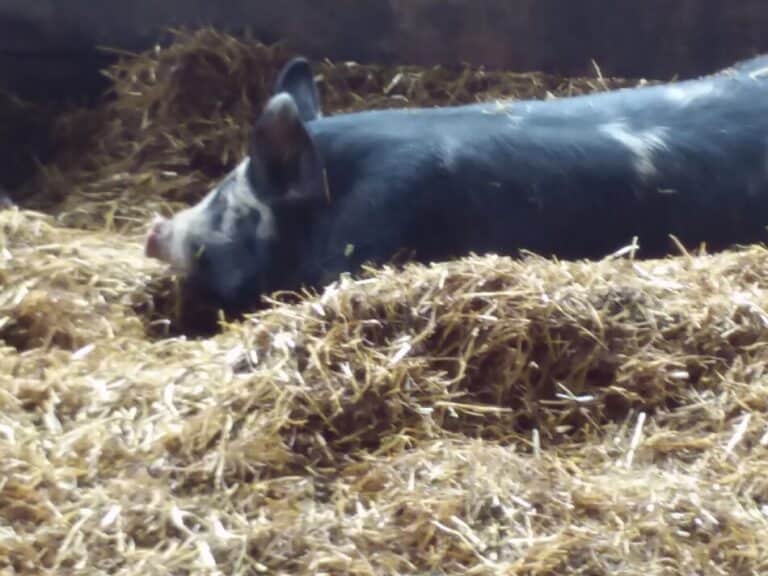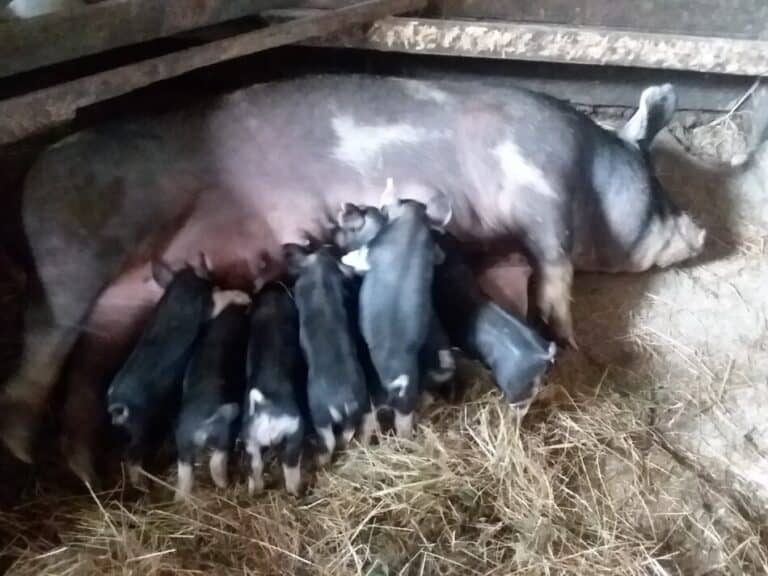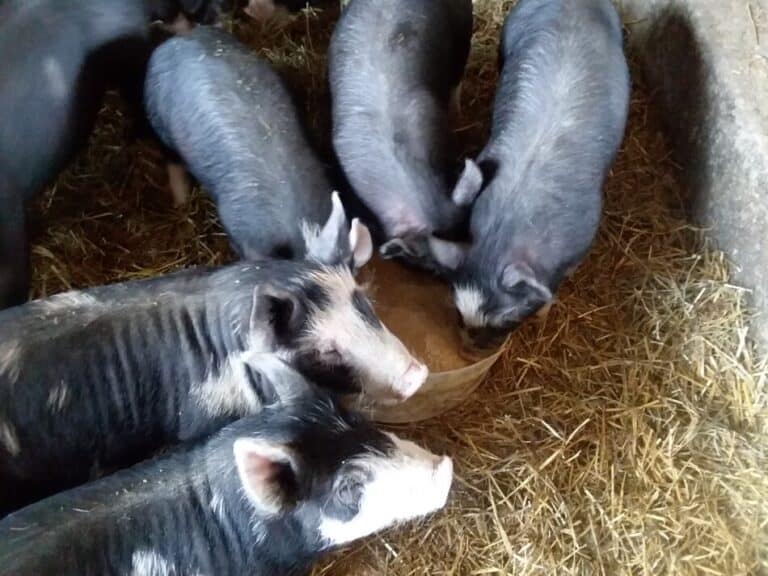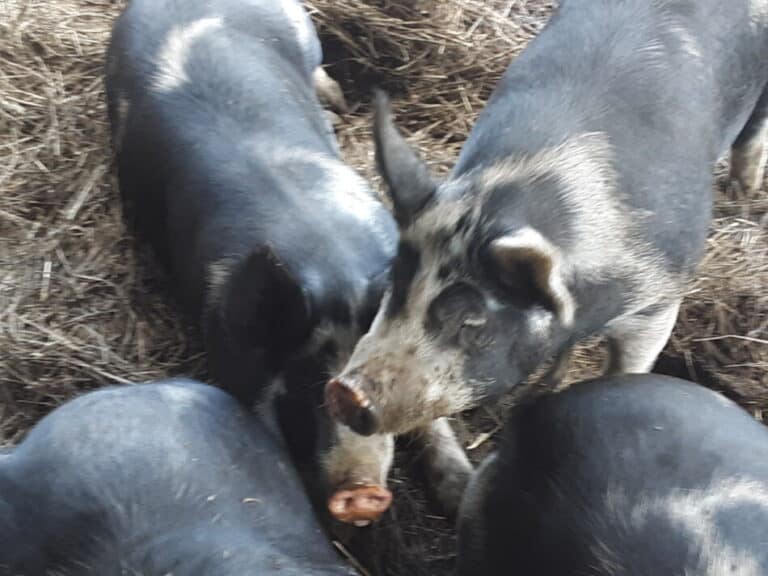How Much Space Do I Need To Raise Pigs?
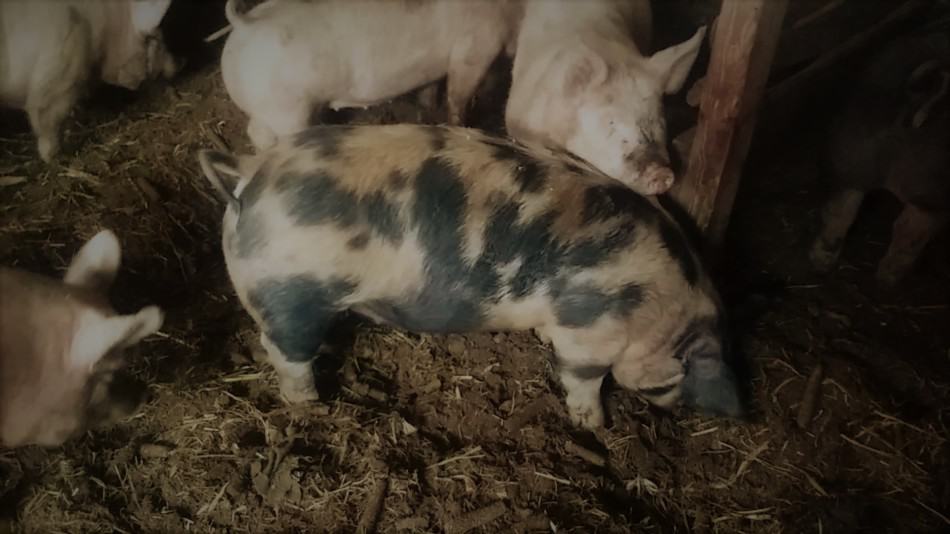
How much space do you need for pigs? The estimates vary widely, just in looking for the past few minutes I’ve found any where from 8 square feet to 10 pigs per acre.
That’s a huge difference, which one will you choose?
Pigs need 80 square feet (8 feet x 10 feet) each in a deep bedding style pen or 1/4 acre (10,890 square feet) for 2-3 pasture raised pigs, which is 3,630-5,445 square feet per pig.
How you decide to raise your pigs depends upon what you have to work with, land and facilities wise, and what you are hoping to do with the pigs.
How To Naturally Raise Healthy Pigs will show you easy things to do to make sure your pigs grow well for you.
| Space per pig | Management system |
| 8 square feet | Confinement Farm |
| 80 square feet | Deep bedding style |
| 1/4 acre for 2-3 pigs | Pasture raised |
For instance, if you want to raise pastured pigs, then there is no getting around it, you need to have some pasture for those pigs!
On the other hand, if you just want your pigs to have a nice pen in the corner of the garage or backyard shed, then you don’t need a pasture at all.
As long as the pigs are happy and healthy, you have a number of options that will all work well.
Here’s a graphic to show some common items and their square footages. I have trouble picturing how big things are in my mind, so this kind of comparison helps me. Hopefully, it’s useful to you, too.

How much space do pigs need?
https://extension.psu.edu/raising-small-groups-of-pigsGenerally, pigs require minimal space. Depending on whether you chose to house pigs inside or outside may determine the amount of space needed per pig. For growing pigs, it is recommended that you plan for around 8 square feet of space per pig.
I have to admit, 8 square feet per pig seems very small to me and since we have the room available I would go bigger.
We like to set up the pig pen area to be more like 8 ft. x 10 ft. per pig and 16 ft. x 10 ft. for two pigs.
There is no magic to the math, just double the amount of square feet available for two pigs and triple it for three pigs, easy!
That works out to 80 square feet per pig, 160 square feet for two pigs and so on.
How big is 8 x 10?
How big is 8 ft. x 10 ft.? Here are a few common examples.
You need more than this per pig
The size of a full sheet of plywood is 4 ft. x 8 ft. (32 square feet), so is the cargo area in the bed of a standard size pickup truck.
The area needed per pig is a little larger than these two examples.
This is more than enough space per pig
In the United States, the size of parking spaces varies. Typically they fall between 7.5 to 9 feet wide and 10 to 20 feet long. The most common size is 8.5 feet wide by 19 feet long.
www.reference.com/world-view/big-parking-space-10383836d25254a0
The second example is a common size for parking spaces in the U.S. is 8.5 ft. x 19 ft. (reference.com) This means the size of a parking space is actually bigger than the size you would need for your pig.
Additionally, some of the larger parking spaces are big enough for two pigs. How? Let’s do some math.
8.5 x 19=161.5 sq. ft. That’s the size of an average parking space
16 x 10=160 sq. ft. That’s the size you need to have a beautiful pen for both of your pigs! (Remember, each pig needs 80+ sq. ft.)
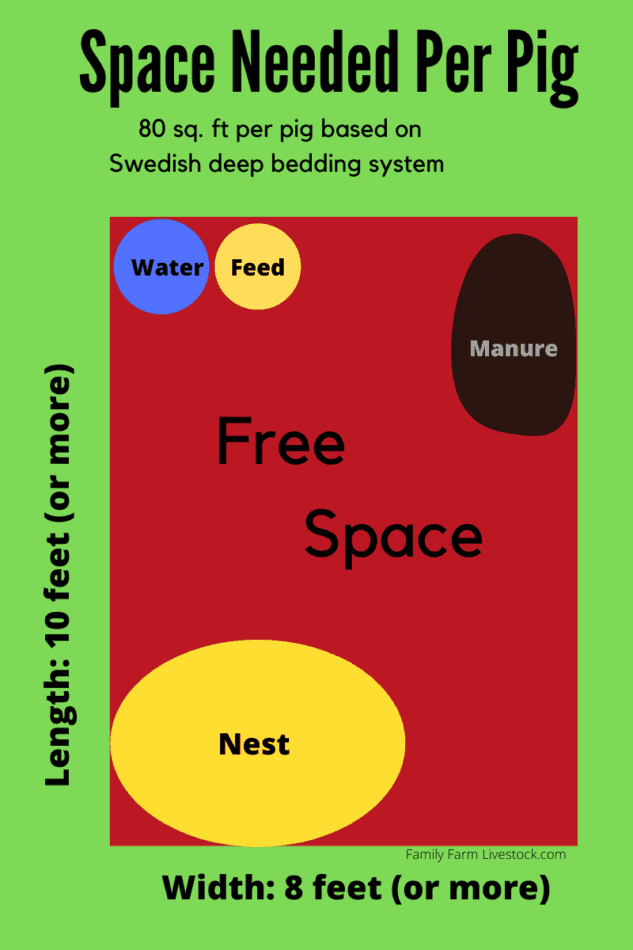
Arrange the pig pen to have a nest and free space
- Water and feed easy for you to fill
- Nest area away from water
- Free space in the middle
- Pigs choose the manure area
Water and feed easy to reach
The best thing you can do as far as arranging the pen is to make sure that the water and the feed are the easiest to reach, since you will be carrying buckets or dragging in a hose.
Nest: opposite the water
Pigs love to spill water. Sad, but true. Keep the nest area away from the water so they don’t mess up all of the bedding if they manage a spill.
I also try to make it so the water will overrun outside of the pen if I get distracted and let the hose run too long. This isn’t always workable in every pen, but if I can make it happen, I do.
I make sure the pen has plenty of bedding overall, then throw in a pile or bale of bedding for them to spread out or make a nest as they please.
This is also a nice way to keep them busy!
If you want the nest in a specific spot, you can “suggest” where you want the pigs to have their nest by bedding that area well and seeing if they agree with your choice.
They might or they might not. They’ll sleep in the spot they choose and will move the bedding to suit their needs.
Free space in the middle of pig area is for exercise
This is the exercise and exploring area for the pig. I like to throw in the occasional special snacks, like hay or a cow pie, in this area to keep the pigs happy.
Your pigs will love to root and reroot through the bedding, as well and the free space gives them the needed room.
One of the best parts about this type of pen set up is that when you double the pigs in the pen, you more than double the free space.
Why? The difference in space needed for two pigs vs. one pig in the nest or to use the manure area are small.
The additional free space is larger since the two pigs share but not double the manure area and nest.
Please note: your pigs will pick where they lay and where they poo. You can suggest places by where you put extra bedding, but in the end, the pigs will do what they think is best.
What can you make the pen out of?
If your pig pen floor is dirt, the easiest thing to make the pen from is T posts and hog or cattle panels.
Pigs have a knack for rearranging their living area. If you skimp on bedding material, this will mean rearranging the dirt floor for you, especially if it gets wet.
If the pen floor is concrete, consider anchoring a post or two in the concrete and using those as support for the pen. Just sitting the panels or any other gates on top of the cement will not keep the pigs in.
When you first get the feeder pigs they will try to squeeze through any small holes, then once they get some size, that’s when the lifting starts.
Pigs are ace “lift and leave” escape artists. (This is the reason to anchor the pen posts to the ground.)
There really is no limit to the things you can use to build a pig pen.
As long as the materials are secure and safe for both you and the pigs, use whatever you can come up with.
Be sure to think strong, pigs are more capable with that snout than you might guess!
Keep the pig feed covered
Be sure to keep the feed in a covered container. If the pigs get out, they’ll find it and probably get bags open or just rip a hole in the side. Motivated pigs can really make some things happen!
What we are really doing here is keeping the feed exposed to the birds and rodents to a minimum. The easier it is to get into, the more friends they will bring with them on the next pig feed raid.
Remember: pigs need plenty of water
Be sure to allow a space for a waterer.
The best spot is one that is easy to fill and easy to securely anchor in place. A corner is ideal, so you have support from two sides.
As the pigs grow, especially if you are raising them in the summer, you will need to give them plenty of water.
Make sure they have a waterer that makes giving them water easy on you.
If they are out of water, the next time you check on them, they need more total water for the day. Come back more frequently or get a bigger waterer.
Enclosed pig pen caution: pigs need ventilation
Pigs need fresh air, even in the winter. Do not keep your pigs in a building or room of a building that can be completely closed off from the outside air.
Pigs need the breeze in the summer and the fresh air in the winter.
It’s better for your pigs that they are kept in colder, well ventilated air in the winter, rather than in a warmer spot, that you would be comfortable in.
Pigs, like most farm animals, are more comfortable at lower temperatures than you.
Keep your pigs out of drafts and direct sunlight, of course, but do not keep them in an area that gets overly hot or has completely blocked air flow.
More air flow over the top of the pen is always better for the health of the pigs.
Land need for pastured pigs is 1/4 acre per 2-3 pigs
Two or three pigs can be done on a quarter acre as shown here. Ten pigs can be done on a full acre with proper management.
Walter Jefferies, Sugar Mountain Farm
http://sugarmtnfarm.com/2013/09/25/south-weaner-paddock/
If you look around online, the amount of land needed per pig on pasture varies quite a bit.
Walter Jeffries and his family have been raising pastured pigs in Vermont for ages, so we’ll go with his numbers.
In the United States, residential lawns average 10,871 square feet (or roughly a quarter of an acre). This depends greatly on location.
Homeadvisor.com, How big is the average lawn?
Now look above and notice that the average lawn (noted in the home advisor quote above) has enough acreage, exactly enough!, for the family in that house to raise a few pigs!
Good news, lawns everywhere across America can start being productive and feeding citizens nutritious home grown food. On to the next question.
Next question: How do we keep them in? Answer-electric fence!
Keeping in your pastured pigs requires training
Pigs are easy to keep in behind an electric fence, once they are trained to the fence.
Don’t just turn them out and expect them to know what the fence is, they don’t.
Train the piglets to the fence
Put them in a solid fence pen with a hot (has power) electric wire strung across a corner.
Make it so they have room to avoid the wire when they want to avoid it.
Now what do you do? Nothing, just wait.
What you will notice, actually hear, is as the pigs get brave enough or curious enough to touch the wire, you’ll hear a squeal. It got zapped.
Once you hear one squeal per pig, that is usually enough for them to understand not to touch it anymore. Give them a few days to be sure.
Now they can go out with the electric fence
Now the pigs can be moved to a completely electric fence and they will stay in as long as you have the wires at pig nose level and keep it hot.
Remember, pigs root. So if they are rooting up clumps of dirt and one lands on the wire, now the fence is shorted out and no longer keeping in the pigs.
How to deal with this? Check the fence and handle small problems early.
Don’t forget, your pigs will still need care, food, water and shade or shelter even when outside.
How Many Pigs on 5 Acres will show you potential ways to set up your pig’s pasture area so they have fresh grass and you keep the grass damage minimal.
Won’t pigs stink up my yard?
This is a common misconception. Well cared for pigs do not stink.
However, it is possible to manage, or should I say mismanage them in a way that makes them and their living area smelly.
The key to smell free pig raising is space and bedding
What is the mystery ingredient here that makes the difference between stinky pig pens and pig pens that don’t smell? Deodorant? Air fresheners?
Kidding about the deodorant and air fresheners, of course, but not kidding about eliminating the stink. What’s the big key to success? Bedding, lots of bedding.
Bedding materials to use for pigs
You can use straw, wood chips, mulch or anything else that will absorb the liquid and the nutrients from the manure.
Many people use a mixture of straw and wood chips or sawdust as needed. Using a mix or just shorter length bedding will make clean out easier on you.
Longer fiber bedding tends to “hold” the bedding together, like carpet. Short stuff is easier to break apart, that’s why sawdust is so popular.
Give the pigs plenty of bedding to play with and they will keep busy during the day spreading it out in the pen.
Pigs Don’t Need To Stink! is an article I wrote detailing ways to keep your pig pen nice for you and the pigs, spoiler alert: it’s all about the bedding!
Here’s an easy test
If you can smell the manure, you need more bedding. The pen should not smell or be wet. Put a knee down in the pen.
Any thing on your pants? If so, you need more bedding.
What about the manure?
Your best bet with the manure is to compost it. Keep up with the bedding materials and the pigs will keep all but the manure and waterer areas nice and dry.
When the pigs are ready to butcher, clean out the dirty “potty” area of the pen and any wet spots and compost them.
Any dry bedding can stay in the pen for another animal, like chickens to scratch around in, or be pitched out into the compost pile as well.
Your compost is ready to use when you poke around in it and you smell dirt. Don’t rush, this will take a few months of warm weather to work.
If you smell manure, it’s not ready and likely does not have enough bedding material to compost properly.
